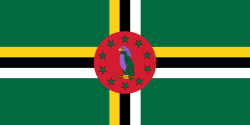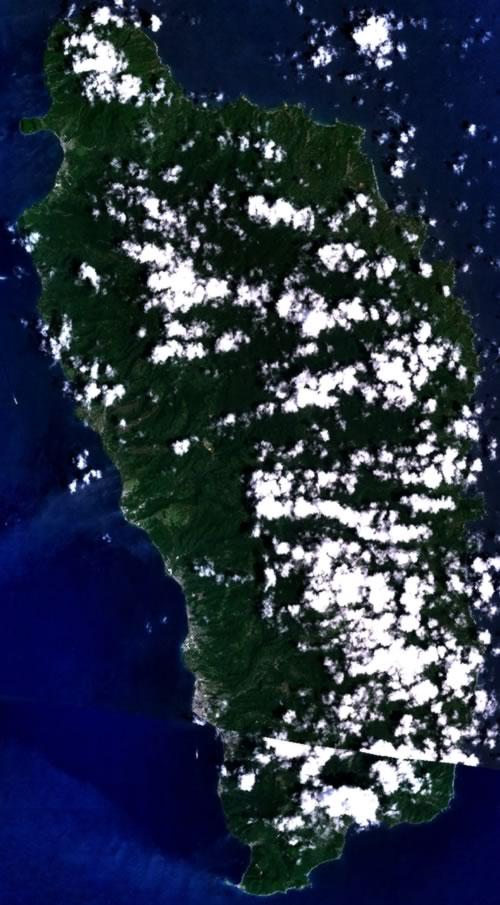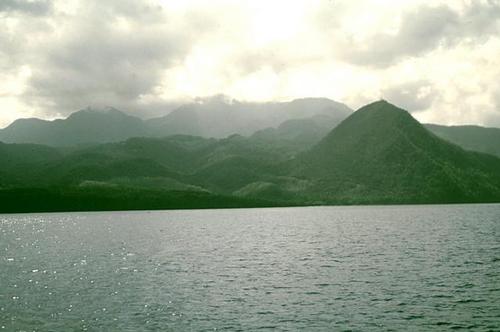DOMINICA
Geography and Landscape

Geography and Landscape
| Basic information | |
| Official language | English |
| Capital | Roseau |
| Area | 751 km² |
| Population | 72,283 (2021) |
| Currency | Eastern Caribbean dollar (XCD) |
| Web | .dm |
| Code. | DMA |
| Tel. | +767 |

Geography and Landscape
Geography
Dominica is a volcanic island and belongs to the eastern Caribbean island group: the Lesser Antilles. The island is home to the independent Commonwealth of Dominica (not to be confused with the Dominican Republic).

Landscape
 Morne Diablotin, highest point of DominicaPhoto: LEE Siebert / PD in the public domain
Morne Diablotin, highest point of DominicaPhoto: LEE Siebert / PD in the public domain
Dominica's landscape is one of the most beautiful in the Caribbean. The island is located between the French islands of Martinique and Guadeloupe. To the north there is the Atlantic Ocean. The Caribbean Sea is to the south of the island. Dominica has a surface area of about 750 square kilometres. The island is 25 kilometres wide and approximately 46 kilometres long. With this surface Dominica is the largest island of the Lesser Antilles. The coastline is generally rocky and jagged. Only a few bays have sandy beaches. Coral reefs and multicoloured fish abound along the coastline.
The highest point in the north, Morne Diablotin, is 1600 metres high. The entire length of the island has a mountain range created by volcanic activities, with the Morne des Moulin and the Morne Trois Pitons in the south. These mountains have a height of no less than 1356 metres. The latter consists of three mountains and has a total area of about 70 square kilometres. In this area you will find the Middleham waterfalls and deep crater lakes such as Fresh Water Lake and Boeri Lake. Also located here is one of the largest warm water lakes in the world called Boiling Lake. All of Dominica's natural areas are protected by national parks and reserves such as Morne Trois Pitons National Park, The Northern Forest Reserve, Cabrits National Park and Scott's Head-Soufriere Marine Reserve. The island also has numerous rivers and lakes that flow from the mountains to the coast.
Climate and Weather
Dominica's climate is tropical. The dry season falls in the months of November to April. The average temperature during this period is around 25°C. In the other months the temperature often lies above 30°C. At night, too, the temperature often remains around 20 °C. The water has an average temperature of 24°C. During the months of May to October, there are occasional tropical rain showers. The months of August, September and October are the rainiest. The months of March, May and June have the least rain. The rainfall differs per area. In the mountains it rains six times as much as along the coast. In general, it can be said that the western part of the island is drier than the eastern part. In the autumn, there is a small chance of hurricanes.
Plants and Animals
Plants
Dominica has many plant, tree and flower species. The slopes of the volcanoes are largely covered with extensive rainforests. There grow many tropical tree species such as mahogany trees, gourds and rubber trees. The hibiscus and bougainvillea are common flowering plant species. Along the coast there are many palm trees. Orchids grow almost everywhere on the island. The national flower is the Bwa Carib. Dominica is the greenest of the Caribbean islands and for this reason is also called the green oasis. Common plants and trees are the flamboyant, calabash, coconut palm, mango and nutmeg.
Animals
As many as 160 bird species live on the island, especially in the rainforests. The Sisserou parrot or Emperor Amazon, measuring fifty centimetres in length, is Dominica's national bird with green and violet-blue wings. This bird is found throughout the Northern Forest Reserve. Another rare parrot is the Jacquot. It is smaller and has bright green feathers with a red neck. This species of bird is found mainly in the lower mountain areas. Furthermore, thirteen species of bats and five species of snakes live on the island. None of the latter are poisonous. A popular delicacy is the mountain chicken, a large species of frog. The coral reefs are home to many colourful fish species together with anemones and rare coral species. Common aquatic animals are the blue marlin, the dolphin, the bonefish, the barracuda, the tarpon and the kingfish. Every year large groups of whales appear off the coast of Dominica to mate and give birth to their offspring.
Sources
Elmar Landeninformatie
Wikipedia
CIA - World Factbook
BBC - Country Profiles
Copyright: Team The World of Info